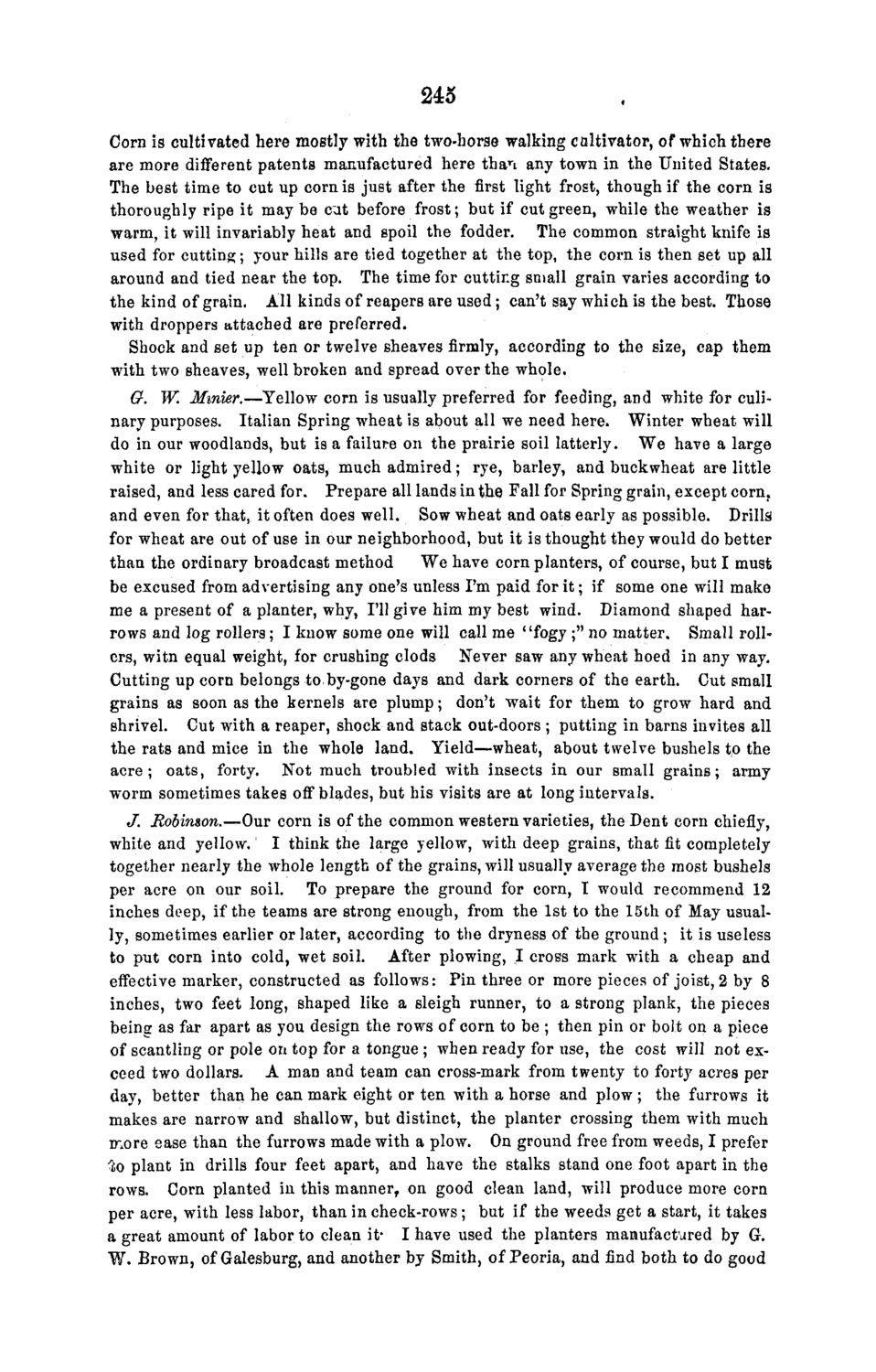| |
| |
Caption: Board of Trustees Minutes - 1868
This is a reduced-resolution page image for fast online browsing.

EXTRACTED TEXT FROM PAGE:
245 Corn is cultivated here mostly with the two-horse walking cultivator, of which there are more different patents manufactured here than any town in the United States. The best time to cut up corn is just after the first light frost, though if the corn is thoroughly ripe it may be cat before frost; but if cut green, while the weather is warm, it will invariably heat and spoil the fodder. The common straight knife is used for cutting; your hills are tied together at the top, the corn is then set up all around and tied near the top. The time for cutting small grain varies according to the kind of grain. All kinds of reapers are used; can't say which is the best. Those with droppers attached are preferred. Shock and set up ten or twelve sheaves firmly, according to the size, cap them with two sheaves, well broken and spread over the whole. G. W. Mmier.—Yellow corn is usually preferred for feeding, and white for culinary purposes. Italian Spring wheat is about all we need here. Winter wheat will do in our woodlands, but is a failure on the prairie soil latterly. We have a large white or light yellow oats, much admired; rye, barley, and buckwheat are little raised, and less cared for. Prepare all lands in the Fall for Spring grain, except cornf and even for that, it often does well. Sow wheat and oats early as possible. Drills for wheat are out of use in our neighborhood, but it is thought they would do better than the ordinary broadcast method We have corn planters, of course, but I must be excused from advertising any one's unless I'm paid for it; if some one will make me a present of a planter, why, I'll give him my best wind. Diamond shaped harrows and log rollers; I know some one will call me "fogy ;" no matter. Small rollers, witn equal weight, for crushing clods Never saw any wheat hoed in any way. Cutting up corn belongs to by-gone days and dark corners of the earth. Cut small grains as soon as the kernels are plump; don't wait for them to grow hard and shrivel. Cut with a reaper, shock and stack out-doors ; putting in barns invites all the rats and mice in the whole land. Yield—wheat, about twelve bushels to the acre; oats, forty. Not much troubled with insects in our small grains; army worm sometimes takes off blades, but his visits are at long intervals. J. Robinson.—Our corn is of the common western varieties, the Dent corn chiefly, white and yellow. I think the large yellow, with deep grains, that fit completely together nearly the whole length of the grains, will usually average the most bushels per acre on our soil. To prepare the ground for corn, I would recommend 12 inches deep, if the teams are strong enough, from the 1st to the 15th of May usually, sometimes earlier or later, according to the dryness of the ground; it is useless to put corn into cold, wet soil. After plowing, I cross mark with a cheap and effective marker, constructed as follows: Pin three or more pieces of joist, 2 by 8 inches, two feet long, shaped like a sleigh runner, to a strong plank, the pieces being as far apart as you design the rows of corn to be ; then pin or bolt on a piece of scantling or pole on top for a tongue ; when ready for use, the cost will not exceed two dollars. A man and team can cross-mark from twenty to forty acres per day, better than he can mark eight or ten with a horse and plow ; the furrows it makes are narrow and shallow, but distinct, the planter crossing them with much more ease than the furrows made with a plow. On ground free from weeds, I prefer •£o plant in drills four feet apart, and have the stalks stand one foot apart in the rows. Corn planted in this manner, on good clean land, will produce more corn per acre, with less labor, than in check-rows; but if the weeds get a start, it takes a great amount of labor to clean it* I have used the planters manufactured by G-. W. Brown, of Galesburg, and another by Smith, of Peoria, and find both to do good
| |